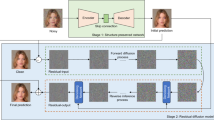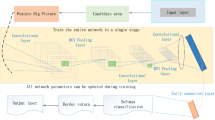Abstract
Existing methods for image denoising mainly focused on noise and visual artifacts too much but rarely mentioned the loss of edge information. In this paper, we propose a deep denoising network based on the residual learning and perceptual loss to generate high-quality denoised results. Inspired by the deep residual network, two new strategies are used to modify the original structure, which can improve the learning process by compressing the mapping range. At first, the high-frequency layer of noisy image is used as the input by removing background information. The secondly, a residual mapping is trained to predict the difference between clean and noisy images as output instead of the final denoised image. Furtherly improve the denoised result, a joint loss function is defined as the weighted sum of pixel-to-pixel Euclidean loss and perceptual loss. A well-trained convolutional neural network is connected to learn the semantic information we would like to measure in our perceptual loss. It encourages the train process to learn similar feature representations rather than match each low-level pixel, which can guide front denoising network to reconstruct more edges and details. As opposed to the standard denoising models that concentrate on one specific noise level, our single model can deal with the noise of unknown levels (i.e., blind denoising). The experiments show that our proposed network achieves superior performances and recovers majority of missing details from low-quality observations.













Similar content being viewed by others
Explore related subjects
Discover the latest articles and news from researchers in related subjects, suggested using machine learning.References
Badrinarayanan V, Kendall A, Cipolla R (2017) Segnet: a deep convolutional encoder–decoder architecture for scene segmentation. IEEE Trans Pattern Anal Mach Intell 99:2481–2495
Buades A, Coll B, Morel JM (2005) A non-local algorithm for image denoising. In: Computer vision and pattern recognition, 2005. CVPR 2005. IEEE computer society conference on, vol 2, pp 60–65
Burger HC, Schuler CJ, Harmeling S (2012) Image denoising: can plain neural networks compete with BM3D? In: IEEE conference on computer vision and pattern recognition, pp 2392–2399
Chen Y, Pock T (2017) Trainable nonlinear reaction diffusion: a flexible framework for fast and effective image restoration. IEEE Trans Pattern Anal Mach Intell 39(6):1256–1272
Dabov K, Foi A, Katkovnik V, Egiazarian K (2007) Image denoising by sparse 3-D transform-domain collaborative filtering. IEEE Trans Image Process 16(8):2080–2095
Elad M, Aharon M (2006) Image denoising via sparse and redundant representations over learned dictionaries. IEEE Trans Image Process 15(12):3736–3745
Gu S, Zhang L, Zuo W, Feng X (2014) Weighted nuclear norm minimization with application to image denoising. In: IEEE conference on computer vision and pattern recognition, pp 2862–2869
He K, Sun J, Tang X (2013) Guided image filtering. IEEE Trans Pattern Anal Mach Intell 35(6):1397–1409
He K, Zhang X, Ren S, Sun J (2015) Deep residual learning for image recognition, pp 770–778
He K, Zhang X, Ren S, Sun J (2016) Identity mappings in deep residual networks, pp 630–645
Jain V, Seung HS (2008) Natural image denoising with convolutional networks. In: International conference on neural information processing systems, pp 769–776
Jia Y, Shelhamer E, Donahue J, Karayev S, Long J (2014) Caffe: convolutional architecture for fast feature embedding, pp 675–678
Johnson J, Alahi A, Li FF (2016) Perceptual losses for real-time style transfer and super-resolution. In: European conference on computer vision, pp 694–711
Kim J, Lee JK, Lee KM (2016a) Accurate image super-resolution using very deep convolutional networks. In: Computer vision and pattern recognition, pp 1646–1654
Kim J, Lee JK, Lee KM (2016b) Deeply-recursive convolutional network for image super-resolution. In: Computer vision and pattern recognition, pp 1637–1645
Krizhevsky A, Sutskever I, Hinton GE (2012) Imagenet classification with deep convolutional neural networks. In: International conference on neural information processing systems, pp 1097–1105
Lan X, Roth S, Huttenlocher D, Black MJ (2006) Efficient belief propagation with learned higher-order Markov random fields. In: European conference on computer vision, pp 269–282
Ledig C, Theis L, Huszar F, Caballero J, Cunningham A, Acosta A, Aitken A, Tejani A, Totz J, Wang Z (2016) Photo-realistic single image super-resolution using a generative adversarial network. In: IEEE conference on computer vision and pattern recognition, pp 105–114
Mao XJ, Shen C, Yang YB (2016) Image restoration using convolutional auto-encoders with symmetric skip connections
Nah S, Kim TH, Lee KM (2017) Deep multi-scale convolutional neural network for dynamic scene deblurring, pp 257–265
Ni Z, Ma L, Zeng H, Cai C, Ma KK (2016) Gradient direction for screen content image quality assessment. IEEE Signal Process Lett 23(10):1394–1398
Ni Z, Ma L, Zeng H, Jing C, Cai C, Ma KK (2017) ESIM: edge similarity for screen content image quality assessment. IEEE Trans Image Process A Publ IEEE Signal Process Soc 26(10):4818–4831
Ono S, Yamada I (2016) Color-line regularization for color artifact removal. IEEE Trans Comput Imaging 2(3):204–217
Osher S, Burger M, Goldfarb D, Yin W (2011) An iterative regularization method for total variation based image restoration. In: IEEE international conference on imaging systems and techniques, pp 170–175
Rudin LI, Osher S, Fatemi E (1992) Nonlinear total variation based noise removal algorithms. In: Eleventh international conference of the center for nonlinear studies on experimental mathematics: computational issues in nonlinear science: computational issues in nonlinear science, pp 259–268
Wang Y, Gong J, Zhang D, Gao C, Tian J, Zeng H (2011) Large disparity motion layer extraction via topological clustering. IEEE Trans Image Process 20(1):43–52
Xie J, Xu L, Chen E (2012) Image denoising and inpainting with deep neural networks. In: International conference on neural information processing systems, pp 341–349
Yang A, Zeng H, Chen J, Zhu J, Cai C (2016) Perceptual feature guided rate distortion optimization for high efficiency video coding. Multidim Syst Signal Process 28(4):1–18
Zeng H, Ma KK, Cai C (2010) Hierarchical intra mode decision for H.264/AVC. IEEE Trans Circ Syst Video Technol 20(6):907–912
Zeng H, Ma KK, Cai C (2011) Fast mode decision for multiview video coding using mode correlation. IEEE Press, Oxford
Zeng H, Wang X, Cai C, Chen J (2014) Fast multiview video coding using adaptive prediction structure and hierarchical mode decision. IEEE Trans Circ Syst Video Technol 24(9):1566–1578
Zha Z, Liu X, Huang X, Shi H, Xu Y, Wang Q, Tang L, Zhang X (2017) Analyzing the group sparsity based on the rank minimization methods. In: IEEE international conference on multimedia and expo, pp 883–888
Zhang H (2016) Convolutional sparse coding-based image decomposition. In: British machine vision conference
Zhang K, Zuo W, Chen Y, Meng D, Zhang L (2017) Beyond a gaussian denoiser: residual learning of deep CNN for image denoising. IEEE Trans Image Process 26(7):3142–3155
Zhu J, Zeng H, Liao S, Lei Z, Cai C, Zheng LX (2017) Deep hybrid similarity learning for person re-identification. IEEE Trans Circ Syst Video Technol 99:1–1
Acknowledgements
This work was supported by National Nature Science Foundation of China Grant no. 61371156.The authors would like to thank the anonymous reviews for their helpful and constructive comments and suggestions regarding this manuscript.
Author information
Authors and Affiliations
Corresponding author
Additional information
Publisher’s Note
Springer Nature remains neutral with regard to jurisdictional claims in published maps and institutional affiliations.
Rights and permissions
About this article
Cite this article
Chen, X., Zhan, S., Ji, D. et al. Image denoising via deep network based on edge enhancement. J Ambient Intell Human Comput 14, 14795–14805 (2023). https://doi.org/10.1007/s12652-018-1036-4
Received:
Accepted:
Published:
Issue Date:
DOI: https://doi.org/10.1007/s12652-018-1036-4




